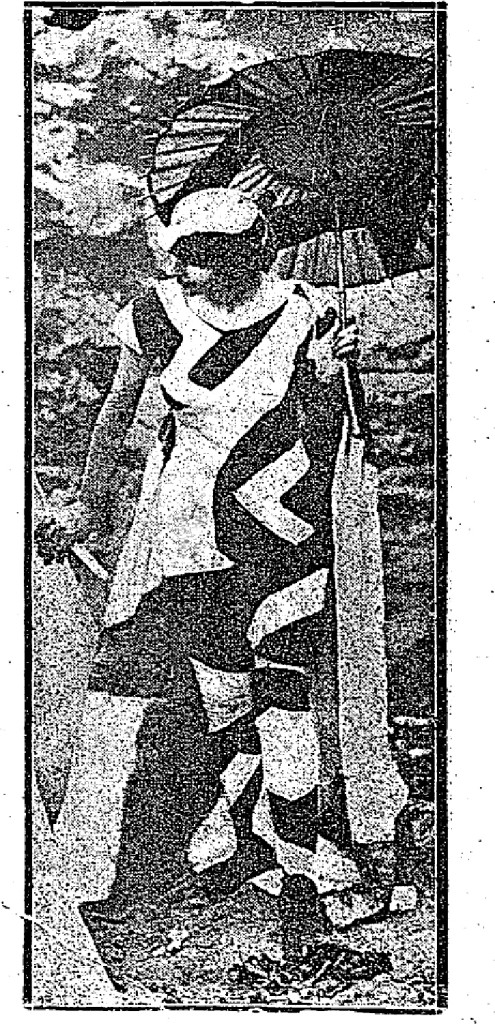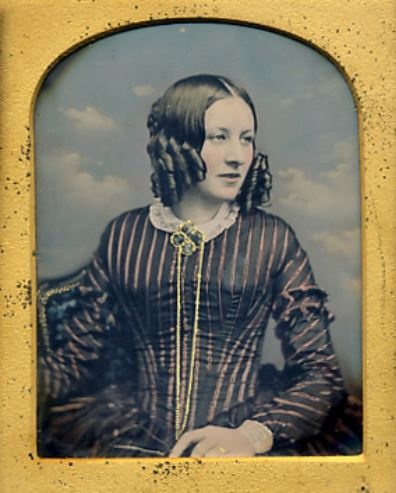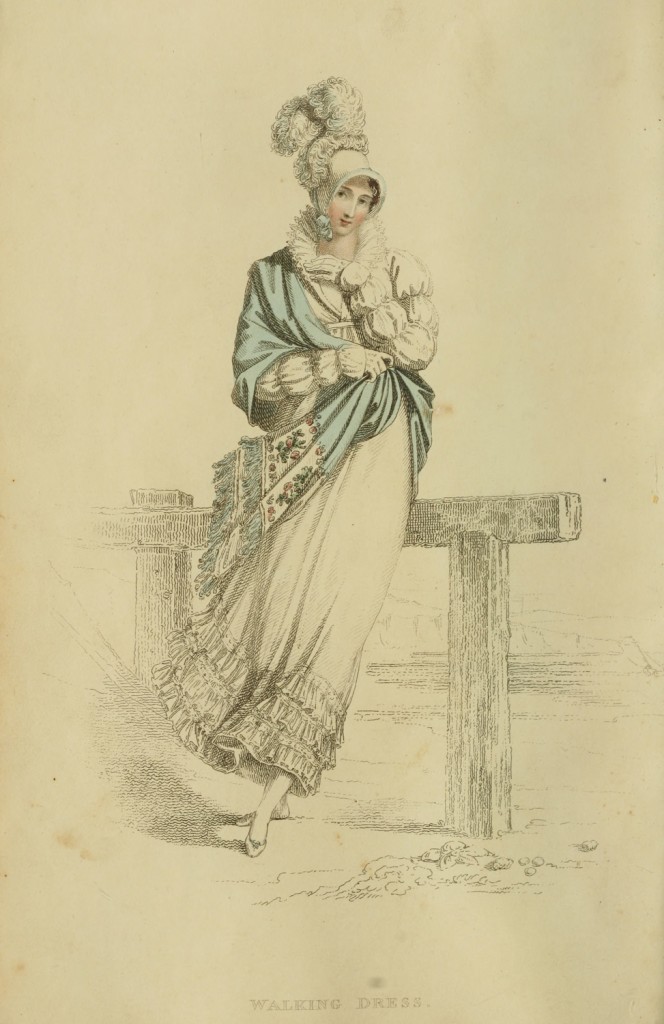April’s Challenge in the Historical Sew Monthly 2015 is War & Peace: Make something that shows the effects of war, or of extended peace.
You may not know this (because it’s not always obvious from what I blog about), but as an undergraduate, I studied international relations. And art history. And costume design. (yes, I like to stay busy).
The relationship between the latter two was obvious: I was focusing on textiles and costume in art history, and in historic costume in costume design. The first one confused a lot of people. It seemed quite random. What does international relations have to do with costume history?
Well, everything. IR is everything that’s going on in the world: looking at why it happens, why countries interact the way they do, how they are likely to act in any given situation, why wars happened, and how their repercussions will effect the rest of the world.
Anything event that significantly impacts your country, or the world as a whole, is going to significantly impact on what you wear. War is, obviously, one of the most significant events that can happen to a country. Get involved in an extended war, with all your nations resources turned toward the war, and there are going to be clothing shortages, and a rise in patriotic and military inspired motifs. The flow of raw materials: oil, cotton, silk, linen, dye, may be interrupted, meaning that those materials are unavailable.
Clothing shortages famously occurred during both World Wars, with Germany resorting to making ‘austerity’ corsets out of fabric woven from paper thread in WWI, because Germany been importing most of its cotton and wool.
Patriotic motifs and colours were common in WWII: one of the most popular shades in the US was ‘Air Force Blue’. The Dazzle frocks and swimsuits I posted about last week are another example of patriotism in fashion, as was the name Government silk for rayon.
Military-esque trimmings on women’s spencers and pelisses were very fashionable during the Napoleonic wars.

Regency Silk Spencer Jacket. Circa 1819-1822, Metropolitan Museum of Art, 1975.34.9
During the American Civil War the South did not sell cotton to the North, and the North attempted (mostly successfully) to blockade the South, preventing goods from reaching the South, and Southern cotton from being exported to Britain, resulting in cotton shortages across Europe, and everything shortages across the South.
While the affects of war on fashion are quite famous, extended periods of peace can also affect fashions. Their effect is more subtle, and harder to pinpoint, but it can be seen. With extended peace countries are able to trade goods and ideas freely, new materials are seen, fashions become more elaborate and decadent, as resources and innovations can be focus on domestic goods and fashions.
Extended periods of (relative) peace along the Silk Road, for example, allowed Chinese silks to make it all the way to Rome (much to the governments displeasure, as they disliked the sort of free trade that saw Roman gold leaving the country for foreign silks.
For much of the 19th c., from the Congress of Vienna to the outbreak of WWI , Europe benefited from the (relative) peace of the Pax Britannica. It is not a cooincidence that this era saw enormous advances in science and industry, all of which affected fashions. Trains, steamships, telegraphs, photography, and advances in printing all assisting in spreading new fashions around the globe at ever increasing rates.
There were also advances in what kinds of fashions could be spread, like the discovery of aniline dyes (hugely helped by the peace, and an exchange of ideas between Britain and Continental Europe).
I will admit that tracing a fashion to a lack of a specific incident (war) can be trickier than tracing it to a specific incident, and not all fashions that arise during peacetime develop specifically because it is an extended peacetime, but it’s still a fascinating idea to tease out.
I hope I’ve given you plenty to think about! Whatever you make, be sure to consider how it was affected by war or peace, and how that shaped it as a costume and fashion.






Oh I’m so excited! I think this is my favorite challenge so far this year! I totally get the influence of culture and history and fashion! I learned that as I wrote our world history curriculum that I taught my kids and while I researched clothing of each era for my kids and I to wear at our history presentations!
I’ve also figured out how to use my blue challenge that became my stash busting challenge to now be my peaceful entry for the War and Peace challenge!
Laurie
I did a similar thing – my Stash-busting challenge was also my Foundations challenge – now I’ve done a joint Blue and War & Peace one:
https://sinistrainksteyne.wordpress.com/2015/04/04/hsm15-behold-the-balaclava/
No idea what I’m going to do next!
“For much of the 19th c., from the Congress of Vienna to the outbreak of WWI , Europe benefited from the (relative) peace of the Pax Britannica.”
*cough* There’s actually a nice little string of wars between Bismarck’s Germany and neighboring countries between 1864 and 1871.
Which reminds me of a particular children style I could track down for this challenge…
Oh absolutely. It was a relative peace, not a total piece – hence the very obvious caveat! There was also the Crimean War, and the various conflicts at the British Empire’s outer edges (Boer War, NZ Wars, rebellions in India etc.). The former was, more or less, a peace-preserving war: stifle Russia’s military ambitions and prop up the Ottoman empire, and prevent a much longer, bigger series of wars in the area. And the latter did little to affect Europe’s general trade and prosperity. Despite these conflicts, the 19th c was an very peaceful period for Europe compared to almost any other era of history.
What about doing a post WWII Dior “New Look” dress?
Not within the HSF era I’m afraid – it ends at 1945. However, you could do a pre-war Winterhalter inspired dress, a la Queen Elizabeth the Queen Mother’s wardrobe. As long as you could justify and explain why it was a product of war or peacetime!
I’m sorry, but I think I’m going to have to sit this one out. April promises to be busier than usual for me, and I will be traveling for four or five days during the middle of it.
This is the challenge where I have no inspiration at all, and I have a deadline for a really big costume project before going on holiday and returning on April 27. Hopefully buy then people have posted a lot of fascinating entries that I can be inspired from.
I love the idea of looking at the influence of longer peacetimes on fashion – maybe ideas and innovations travel more easily and faster than across frontlines? Luxury items and accessories of all sorts as well as a wide variety of fabrics etc are available as not so much effort and money is poured into arms production? So more lavish and extravagant fashion at more affordable prices? Less pressure on women to express their patriotism in fashion, too, e.g. by extra frugal dress, more military-inspired details etc.?
This is a very fascinating but also very, very challenging challenge!! I made a sailor shirt for my son and I´m curious if Martha came up with the same idea
https://blumenundfedern.wordpress.com/2015/04/27/historical-sew-monthly-4-war-and-peace-the-ambiguous-nature-of-the-sailor-suit/
Thank you for bringing up such an interesting topic!
I opted to choose clothing a woman might choose if joining men in war: https://dawnsdressdiary.wordpress.com/2015/04/28/historical-sew-monthly-april-2015-x-dressing-norse/
[…] vous l’avais dejà dit, faute d’inspiration pour ce challenge n°4, Guerre et Paix, j’ai decide de vous faire un post d’histoire de la Mode. Je vous propose donc une […]
I made a blouse from a vintage dress pattern that has lived in my stash for ages. http://levagabondage.blogspot.com/2015/04/hsf-challenge-war-peace.html
My skirt and blouse based off of examples from WWI:
http://isabelladangelo.blogspot.com/2015/04/historical-sew-monthly-war-and-peace.html
Second try … 😉 – here’s my black skirt suit:
https://aboutmybuttonbox.wordpress.com/2015/04/17/hsm-4-war-peace-the-black-is-the-new-black-suit/
blogged:
https://wandabvictorian.wordpress.com/2015/05/03/hsf-15-challenge-4-war-and-peace/
I made a Virginia Regimental Coat. https://americanseamstress.wordpress.com/2015/05/06/hsm-2015-3-1779-virginia-regimental-coat/
I redid a corded petticoat that was made for someone else so that it fit me. Showing an effect of the Civil War on fabric shortages:
http://returningvintage.blogspot.com/2015/05/april-sew-monthly-challenge.html
Late post about a coif – a medieval man’s essential headwear, both on warriors and other, more peaceful classes: https://caddamsbetraktelser.wordpress.com/2015/05/28/hsm-4-warriors-and-peasants/
I did a men’s tunic (Norse, Viking Age) for this challenge: https://dawnsdressdiary.wordpress.com/2015/05/17/norse-mans-tunic/
I’m SUPER late with this challenge, but I wanted to make it up during my year of HSM challenges, sew-along, so here it is!
I did an Empire burgundy quilted silk muff, showing the influences of war on the silk industry of France!
http://theladydetalle.blogspot.com/2015/11/burgundy-quilted-silk-empire-muff-april.html